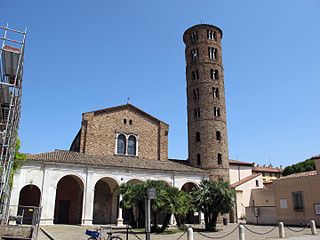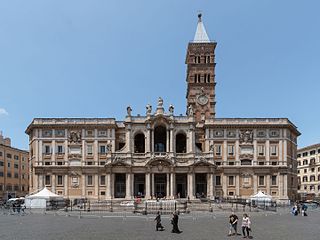 W
WEarly Christian art and architecture or Paleochristian art is the art produced by Christians or under Christian patronage from the earliest period of Christianity to, depending on the definition used, sometime between 260 and 525. In practice, identifiably Christian art only survives from the 2nd century onwards. After 550 at the latest, Christian art is classified as Byzantine, or of some other regional type.
 W
WThe Baptistery of Albenga is a paleochristian religious structure in Albenga, province of Savona, in the region of Liguria of northern Italy. It is an example of 5th-century late-Ancient Roman architecture with mosaic decoration, and stands adjacent to the Albenga Cathedral of San Michele Arcangelo.
 W
WThe Alexamenos graffito is a piece of Roman graffito scratched in plaster on the wall of a room near the Palatine Hill in Rome, which has now been removed and is in the Palatine Museum. It may be meant to depict Jesus; if so, it competes with an engraved gem as the earliest known pictorial representation of the Crucifixion of Jesus. It is hard to date, but has been estimated to have been made c. 200. The image seems to show a young man worshipping a crucified, donkey-headed figure. The Greek inscription approximately translates to "Alexamenos worships [his] god," indicating that the graffito was apparently meant to mock a Christian named Alexamenos.
 W
WThe Basilica of Sant'Apollinare Nuovo is a basilica church in Ravenna, Italy. It was erected by the Ostrogothic king Theodoric the Great as his palace chapel during the first quarter of the 6th century. This Arian church was originally dedicated in 504 AD to "Christ the Redeemer".
 W
WThe Archbishop's Chapel is a chapel on the first floor of the bishops' palace in Ravenna, Italy, the smallest of the famous mosaic sites of the city. It is a private oratory of Trinitarian bishops dating from the turn of the 6th century. Although commonly attributed to St. Peter Chrysologus, Archbishop of Ravenna from 433–450, the chapel was actually built by Peter II shortly after he became archbishop in 495. The mosaics date from the original construction, or soon after.
 W
WThe Arian Baptistry in Ravenna, Italy is a Christian baptismal building that was erected by the Ostrogothic King Theodoric the Great between the end of the 5th century and the beginning of the 6th century A.D., at the same time as the Basilica of Sant' Apollinare Nuovo.
 W
WThe Baptistery of Neon is a Roman religious building in Ravenna, northeastern Italy. The most ancient monument remaining in the city, it was partly erected on the site of a Roman bath. It is also called the Orthodox Baptistery to distinguish it from the Arian Baptistery constructed on behest of Ostrogothic King Theodoric some 50 years later.
 W
WThe Basilica of San Vitale is a late antique church in Ravenna, Italy. The 6th century church is an important surviving example of early Christian Byzantine art and architecture. It is one of eight structures in Ravenna inscribed on the UNESCO World Heritage List. Its foundational inscription describes the church as a basilica, though its centrally-planned design is not typical of the basilica form. The Roman Catholic Church has designated the building a "basilica", an honorific title bestowed on exceptional church buildings of historic and ecclesial importance.
 W
WThe Basilica of Sant' Apollinare in Classe is a church in Ravenna, Italy, consecrated on 9 May 549 by the bishop Maximian and dedicated to Saint Apollinaris, the first bishop of Ravenna and Classe. An important monument of Byzantine art, in 1996 it was inscribed with seven other nearby monuments in the UNESCO World Heritage List, which described it as "an outstanding example of the early Christian basilica in its purity and simplicity of its design and use of space and in the sumptuous nature of its decoration".
 W
WThe Brescia Casket or Lipsanotheca is an ivory box, perhaps a reliquary, from the late 4th century, which is now in the Museo di Santa Giulia at San Salvatore in Brescia, Italy. It is a virtually unique survival of a complete Early Christian ivory box in generally good condition. The 36 subjects depicted on the box represent a wide range of the images found in the evolving Christian art of the period, and their identification has generated a great deal of art-historical discussion, though the high quality of the carving has never been in question. According to one scholar: "despite an abundance of resourceful and often astute exegesis, its date, use, provenance, and meaning remain among the most formidable and enduring enigmas in the study of early Christian art".
 W
WChrist in Majesty or Christ in Glory is the Western Christian image of Christ seated on a throne as ruler of the world, always seen frontally in the centre of the composition, and often flanked by other sacred figures, whose membership changes over time and according to the context. The image develops from Early Christian art, as a depiction of the Heavenly throne as described in 1 Enoch, Daniel 7, and The Apocalypse of John. In the Byzantine world, the image developed slightly differently into the half-length Christ Pantocrator, "Christ, Ruler of All", a usually unaccompanied figure, and the Deesis, where a full-length enthroned Christ is entreated by Mary and St. John the Baptist, and often other figures. In the West, the evolving composition remains very consistent within each period until the Renaissance, and then remains important until the end of the Baroque, in which the image is ordinarily transported to the sky.
 W
WChristian symbolism is the use of symbols, including archetypes, acts, artwork or events, by Christianity. It invests objects or actions with an inner meaning expressing Christian ideas.
 W
WThe Chronograph of 354, also known as the Calendar of 354, is a compilation of chronological and calendrical texts produced in 354 AD for a wealthy Roman Christian named Valentinus by the calligrapher and illustrator Furius Dionysius Filocalus. The original illustrated manuscript is lost, but several copies have survived. It is the earliest dated codex to have full page illustrations. The term Calendar of Filocalus is sometimes used to describe the whole collection, and sometimes just the sixth part, which is the Calendar itself. Other versions of the names are occasionally used. The text and illustrations are available online.
 W
WThe depiction of Jesus in pictorial form was controversial in the early Church. The depiction of him in art took several centuries to reach a conventional standardized form for his physical appearance, which has subsequently remained largely stable since that time. Most images of Jesus have in common a number of traits which are now almost universally associated with Jesus, although variants are seen.
 W
WThe Dogmatic Sarcophagus, also known as the "Trinity Sarcophagus" is an early Christian sarcophagus dating to 320–350, now in the Vatican Museums. It was discovered in the 19th century during rebuilding works at the basilica di San Paolo fuori le Mura, in Rome, Italy.
 W
WThe Dura-Europos church is the earliest identified Christian house church. It is located in Dura-Europos in Syria. It is one of the earliest known Christian churches, and was apparently a normal domestic house converted for worship some time between 233 and 256, when the town was abandoned after conquest by the Persians. It is less famous, smaller, and more modestly decorated than the nearby Dura-Europos synagogue, though there are many other similarities between them.
 W
WMummy portraits or Fayum mummy portraits are a type of naturalistic painted portrait on wooden boards attached to upper class mummies from Roman Egypt. They belong to the tradition of panel painting, one of the most highly regarded forms of art in the Classical world. The Fayum portraits are the only large body of art from that tradition to have survived. They were formerly, and incorrectly, called Coptic portraits.
 W
WThe Mausoleum of Galla Placidia is a Late Antique Roman building in Ravenna, Italy, built between 425 and 450. It was added to the World Heritage List together with seven other structures in Ravenna in 1996. Despite its common name, the empress Galla Placidia was not buried in the building, a misconception dating from the thirteenth century; she died in Rome and was buried there, probably alongside Honorius in the Mausoleum of Honorius at Old Saint Peter's Basilica.
 W
WGold glass or gold sandwich glass is a luxury form of glass where a decorative design in gold leaf is fused between two layers of glass. First found in Hellenistic Greece, it is especially characteristic of the Roman glass of the Late Empire in the 3rd and 4th century AD, where the gold decorated roundels of cups and other vessels were often cut out of the piece they had originally decorated and cemented to the walls of the catacombs of Rome as grave markers for the small recesses where bodies were buried. About 500 pieces of gold glass used in this way have been recovered. Complete vessels are far rarer. Many show religious imagery from Christianity, traditional Greco-Roman religion and its various cultic developments, and in a few examples Judaism. Others show portraits of their owners, and the finest are "among the most vivid portraits to survive from Early Christian times. They stare out at us with an extraordinary stern and melancholy intensity". From the 1st century AD the technique was also used for the gold colour in mosaics.
 W
WThe Good Shepherd is an image used in the pericope of John 10:1–21, in which Jesus Christ is depicted as the Good Shepherd who lays down his life for his sheep. Similar imagery is used in Psalm 23 and Ezekiel 34:11–16. The Good Shepherd is also discussed in the other gospels, the Epistle to the Hebrews, the First Epistle of Peter and the Book of Revelation.
 W
WThe ichthys or ichthus, from the Greek ikhthū́s is a symbol consisting of two intersecting arcs, the ends of the right side extending beyond the meeting point so as to resemble the profile of a fish. The symbol was adopted by early Christians as a secret symbol. It is now known colloquially as the "sign of the fish" or the "Jesus fish".
 W
WThe labarum was a vexillum that displayed the "Chi-Rho" symbol ☧, a christogram formed from the first two Greek letters of the word "Christ" — Chi (χ) and Rho (ρ). It was first used by the Roman emperor Constantine the Great.
 W
WItaly has the richest concentration of Late Antique and medieval mosaics in the world. Although the art style is especially associated with Byzantine art and many Italian mosaics were probably made by imported Greek-speaking artists and craftsmen, there are surprisingly few significant mosaics remaining in the core Byzantine territories. This is especially true before the Byzantine Iconoclasm of the 8th century.
 W
WThe Layos Sarcophagus is a paleochristian sarcophagus found in Layos, Toledo in 1627 and now in Barcelona.
 W
WThe Missorium of Theodosius I is a large ceremonial silver dish preserved in the Real Academia de la Historia, in Madrid, Spain. It was probably made in Constantinople for the tenth anniversary (decennalia) in 388 AD of the reign of the Emperor Theodosius I, the last Emperor to rule both the Eastern and Western Empires. It is one of the best surviving examples of Late Antique Imperial imagery and one of the finest examples of late Roman goldsmith work. It is the largest and most elaborate, and the most famous, of the 19 surviving vessels believed to represent largitio ("largesse") or a "ceremonial gift given by the emperor to a civil or military official".
 W
WThe Monza ampullae form the largest collection of a specific type of Early Medieval pilgrimage ampullae or small flasks designed to hold holy oil from pilgrimage sites in the Holy Land related to the life of Jesus. They were made in Palestine, probably in the fifth to early seventh centuries, and have been in the Treasury of Monza Cathedral north of Milan in Italy since they were donated by Theodelinda, queen of the Lombards,. Since the great majority of surviving examples of such flasks are those in the Monza group, the term may be used to cover this type of object in general.
 W
WThe Parting of Lot and Abraham is one in a series of mosaic scenes, probably dating to the 430s, that decorate the nave wall of Santa Maria Maggiore, one of the most prominent basilican churches in Rome. The mosaic shows the story in the biblical Book of Genesis of the parting of Abraham from his nephew, Lot, as they choose opposing paths. Abraham with Isaac and the rest of his family, chooses the road to Canaan, as God intends him to, and Lot chooses to take his followers to Sodom.
 W
WPortraits of the Apostles are a common subject in Christian art and serve as a devotional tool for many Christian denominations. The Twelve Apostles were instrumental in teaching the gospel of Jesus, “continuing the mission of Jesus” with their depictions continuing to serve as spiritual inspiration and authority. Many Protestant denominations reject religious imagery, including the veneration of the apostles and other religious figures.
 W
WThe Quedlinburg Itala fragment is a fragment of six folios from a large 5th-century illuminated manuscript of an Old Latin Itala translation of parts of 1 Samuel of the Old Testament. It was probably produced in Rome in the 420s or 430s. It is the oldest surviving illustrated biblical manuscript and has been in the Berlin State Library since 1875-76. The pages are approximately 305 x 205 mm large.
 W
WSanta Costanza is a 4th-century church in Rome, Italy, on the Via Nomentana, which runs north-east out of the city. It is a round building with well preserved original layout and mosaics. It has been built adjacent to a horseshoe-shaped church, now in ruins, which has been identified as the initial 4th-century cemeterial basilica of Saint Agnes. Santa Costanza and the old Saint Agnes were both constructed over the earlier catacombs in which Saint Agnes is believed to be buried.
 W
WThe Basilica of Saint Mary Major, or church of Santa Maria Maggiore, is a Papal major basilica and the largest Catholic Marian church in Rome, Italy.
 W
WEarly Christian sarcophagi are those Ancient Roman sarcophagi carrying inscriptions or carving relating them to early Christianity. They were produced from the late 3rd century through to the 5th century. They represent the earliest form of large Christian sculpture, and are important for the study of Early Christian art.
 W
WThe Sarcophagus of Junius Bassus is a marble Early Christian sarcophagus used for the burial of Junius Bassus, who died in 359. It has been described as "probably the single most famous piece of early Christian relief sculpture." The sarcophagus was originally placed in or under Old St. Peter's Basilica, was rediscovered in 1597, and is now below the modern basilica in the Museo Storico del Tesoro della Basilica di San Pietro in the Vatican. The base is approximately 4 x 8 x 4 feet.
 W
WThe St Augustine Gospels is an illuminated Gospel Book which dates from the 6th century. It was made in Italy and has been in England since fairly soon after its creation; by the 16th century it had probably already been at Canterbury for almost a thousand years. It has 265 leaves measuring about 252 x 196 mm, and is not entirely complete, in particular missing pages with miniatures.
 W
WThe Throne of Maximian is a cathedra that was made for Archbishop Maximianus of Ravenna and is now on display at the Archiepiscopal Museum, Ravenna. It is generally agreed that the throne was carved in the Greek East of the Byzantine Empire and shipped to Ravenna, but there has long been scholarly debate over whether it was made in Constantinople or Alexandria.
 W
WThe popularly named "Tomb of the Julii" survives in the Vatican Necropolis beneath St. Peter's Basilica. The serendipitous discovery near the crypt has a vaulted ceiling bearing a mosaic depicting Helios with an aureole riding in his chariot, within a framing of rinceaux of vine leaves. The mosaic is dated to the late 3rd century to early 4th century. Other mosaics in this tomb depicting Jonah and the whale, the good shepherd carrying a lamb, and fishermen have encouraged its interpretation as a Christian tomb.